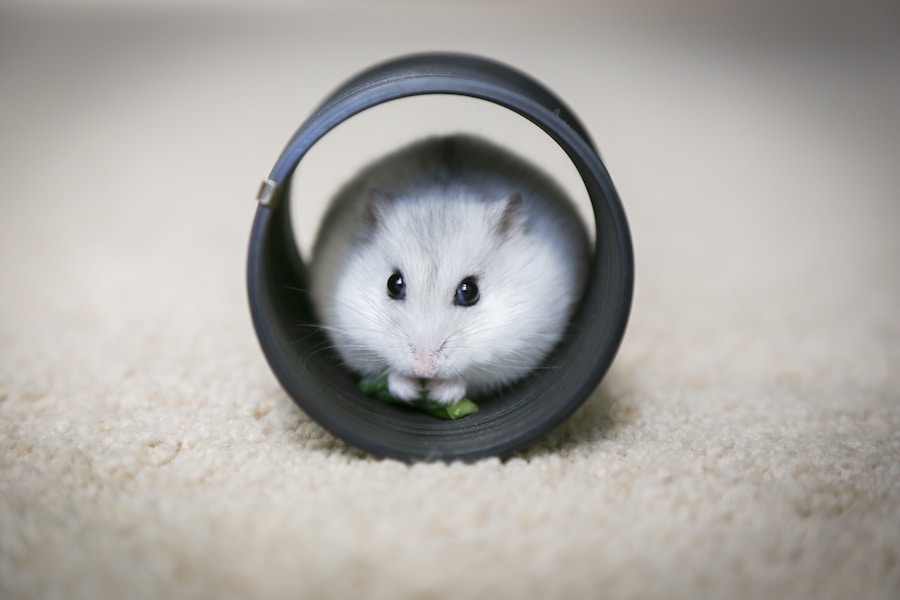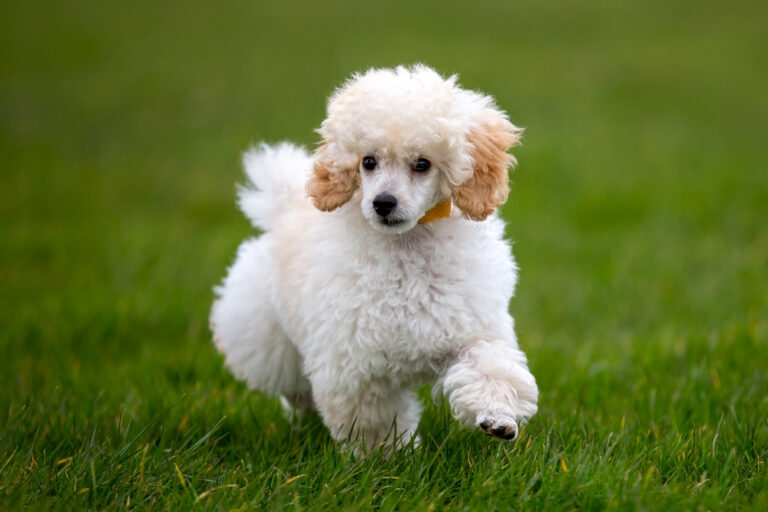- May 17, 2023
Hamster Haven: The Art of Creating a Natural Habitat for Your Furry Friend

Hamsters are cute, cuddly and make great pets, but did you know that they also require a natural habitat to thrive? As a responsible pet owner, it is important to create an environment that mimics your hamster’s natural habitat. In this article, we will guide you through the process of creating a natural habitat for your hamster while discussing the importance and benefits of doing so.
The Importance of Creating a Natural Habitat for Your Hamster
Hamsters are naturally active and curious creatures. They need plenty of space to explore and play in order to stay healthy and happy.
A natural habitat allows them to express their natural behaviors such as burrowing, climbing, running, and foraging that they would do in the wild. A well-designed hamster environment can also help reduce stress levels in your furry friend.

Hamsters are sensitive animals that can easily become stressed if their environment is not suitable or if they feel threatened by their surroundings or other pets around them. Providing them with a safe and secure space can significantly reduce their stress levels and ultimately improve their overall health.
The Benefits of a Natural Habitat for Your Hamster’s Health and Happiness
Creating a natural habitat for your hamster has many benefits beyond just reducing stress levels. A suitable habitat can provide opportunities for exercise which helps prevent obesity – one of the most common health problems among pet hamsters.
It also allows them to engage in playtime activities which promote mental stimulation – essential for good mental health. A well-designed environment will help improve your hamster’s immune system by keeping them physically active, mentally stimulated, providing access to fresh air & water sources as well as appropriate food options.
Improving the quality of life for your pet is essential in ensuring both its physical and emotional well-being. By following our step-by-step guide on creating an ideal natural habitat for your hamster, you’ll be able to create a loving and healthy environment for your furry friend that will enable them to live their best life.
Choosing the Right Cage
Size and Space Requirements for Your Hamster
When selecting a cage for your hamster, it is important to consider the size and activity level of your furry friend. Syrian hamsters (the most common type of pet hamster) require a minimum of 450 square inches of floor space, while dwarf hamsters can get by with around 280-360 square inches.
While some cages may advertise themselves as being suitable for hamsters, it is essential to do your research and ensure that they meet these minimum requirements. Additionally, you should also consider the height of the cage.
Hamsters are natural burrowers and climbers, so a tall cage with multiple levels can provide them with plenty of opportunities for exercise and exploration. When choosing a multi-level cage, make sure that the ramps or ladders are not too steep or slippery to prevent injuries.
Materials to Look For in a Cage
The material and construction quality are also important factors when selecting a suitable habitat for your hamster. A wire mesh cage should have bars spaced no more than half an inch apart; otherwise, your furry friend could escape or even get stuck between them.
Plastic cages are another popular option due to their durability and ease of cleaning. However, make sure that any plastic used in the construction is non-toxic as some plastics can be harmful if ingested by your pet.
Glass aquariums or terrariums can also be used as long as they have adequate ventilation. Keep in mind that these enclosures may require more frequent cleaning due to their lack of airflow.
Accessories to Include in the Cage
Once you have selected an appropriate cage, it’s time to set up some accessories! Hamsters love having plenty of hiding spots such as tunnels, nest boxes or hideouts made from wood or cardboard. Your hamster will also need a water bottle, food dish or bowl, and a place to exercise.
An exercise wheel is an excellent option for providing your hamster with the opportunity to run and burn off some of their energy. When selecting an exercise wheel, make sure it has no holes large enough for your hamster’s feet to get caught in, and is large enough for them to run comfortably without having to arch their backs.
Overall, choosing the right cage and accessories can greatly impact your hamster’s quality of life. By providing plenty of space and enrichment opportunities, you are setting them up for a happy and healthy life in their new habitat!
Bedding Options
Natural Bedding Options
When creating a natural habitat for your hamster, it is important to choose the right bedding. Natural bedding options are the best choice when it comes to creating a healthy and comfortable environment for your pet.
The most popular natural bedding options for hamsters include aspen shavings, paper-based bedding, and hemp bedding. Aspen shavings are a great option because they are soft and easy on your hamster’s feet while still being absorbent enough to control odors.
It is important to make sure that the aspen shavings you choose are free of dust and aromatic oils, as these can be harmful to your hamster’s respiratory system. Paper-based bedding is another great option, especially if you’re looking for an eco-friendly choice.
This type of bedding is made from recycled paper products and is very absorbent, making it a great option if you have multiple hamsters or if your pet tends to be messy. Additionally, paper-based bedding does not produce dust or contain harmful chemicals.
Hemp bedding is another natural option that has become increasingly popular in recent years. This type of bedding is derived from the hemp plant and has many benefits.
It is extremely absorbent and has natural odor control properties, making it a great choice for those who want to keep their home smelling fresh without using harmful chemicals. Hemp bedding also has antimicrobial properties which can help keep your hamster healthy.
Avoiding Harmful Bedding Options
While there are many natural options available when it comes to choosing the right bedding for your hamster, there are also several types of bedding that should be avoided at all costs. Cedar and pine wood shavings should never be used as they contain aromatic oils that can cause respiratory problems in small animals like hamsters. Additionally, clay litter or cat litter should never be used as they contain harmful chemicals that can be toxic to your pet.
It is important to always read the labels of any bedding product you purchase and avoid anything that contains dyes, fragrances, or other additives that may be harmful to your hamster. Remember, a comfortable and safe environment is essential for your hamster’s health and well-being, so choose your bedding options carefully.
Creating a Play Area
The Importance of Playtime for Your Hamster’s Health and Happiness
Just like humans, hamsters also need playtime to stay healthy and happy. Playing helps them exercise and stimulate their minds, which is especially important for captive hamsters who spend most of their time in cages.
A lack of stimulation can cause boredom, stress, and lead to health problems such as obesity or aggression. It’s recommended that hamsters have at least an hour of playtime outside their cage per day.
Setting up a Safe Play Area
When setting up a play area for your hamster, safety should be your top priority. Start by choosing an enclosed space where your hamster can’t escape or get hurt.
You can use a playpen or create a safe enclosed space using cardboard boxes or other materials. Make sure there are no sharp edges or any hazardous materials around the area that could harm your pet.
To make the area more interesting for your furry friend, add tunnels and hideouts to the space. These provide opportunities for exploration and mimic natural burrowing behaviors they would exhibit in the wild.
You can use plastic tubes or PVC pipes to create tunnels or use cardboard boxes with holes cut out as hideouts. Another essential aspect of setting up a safe play area is providing toys and chewables for your hamster to interact with during its time outside the cage.
Toys such as wheels, balls, ladders, rope toys, etc., provide physical activity while also stimulating their mind with new experiences. Chewable toys such as wooden blocks or sticks help keep their teeth trimmed while providing mental stimulation by engaging in natural chewing instincts.
Creating a safe and stimulating play area is crucial to keeping pet hamsters healthy and happy during their time indoors in captivity. By incorporating tunnels and hideouts along with various toys/chewables, you can provide a space for your hamster to explore and play, which could drastically improve its quality of life.
Feeding Your Hamster Naturally
Choosing the Right Food for Your Hamster’s Dietary Needs
Hamsters are omnivores, meaning they eat both plants and animals. It is important to feed them a balanced diet that meets their nutritional needs. Commercial hamster food mixes can be a good starting point, but it is important to read the label and make sure they contain enough protein, vitamins, and minerals.
Look for food that contains at least 16% protein, which is essential for muscle development and repair. Make sure the food does not contain too much fat or sugar, as these can lead to obesity or diabetes.
In addition to commercial hamster food mixes, fresh fruits and vegetables can provide important nutrients for your hamster. Some good options include dark leafy greens like spinach or kale, carrots, broccoli, and apples.
However, it is important not to overfeed your hamster with treats as this can lead to health problems. A good rule of thumb is to offer fresh fruits and vegetables in small amounts once or twice a week in addition to their regular diet.
Incorporating Fresh Fruits and Vegetables into Their Diet
Fresh fruits and vegetables should be washed thoroughly before offering them to your hamster. Remove any seeds or pits as these can be harmful.
Cut the produce into small pieces that are easy for your hamster to eat. Offer fresh produce in a separate dish from their regular food so they don’t get confused about what they should be eating.
It is also important to introduce new foods slowly so you can monitor your hamster’s reaction. Giving them too much of a new food all at once may upset their stomachs or cause digestive issues.
Start with small amounts of one type of fruit or vegetable at a time until you determine what they like best. By providing a balanced diet that includes both commercial hamster food and fresh fruits and vegetables, you can help ensure your hamster stays healthy and happy.
Exercise Wheel Options
Types of exercise wheels available
When it comes to choosing an exercise wheel for your hamster, there are a few options available. The most common types of hamster wheels include wire, plastic, and solid surface wheels. Wire wheels can be dangerous for your hamster due to the risk of their feet getting caught in between the wires.
Plastic wheels are a safer option, but they can be noisy and may not last as long as other types of wheels. Solid surface wheels like those made from metal or wood are sturdier and quieter than other options.
It’s important to choose a wheel that is appropriate for the size of your hamster so they can comfortably run without their back being arched. Another consideration when choosing an exercise wheel is the type of motion it allows your hamster.
Some wheels spin vertically while others spin horizontally. It’s important to observe your hamster’s behavior and preferences when deciding which type of motion they prefer.
Choosing the right size wheel
The size of your hamster wheel should be appropriate for the size of your pet. A small wheel can cause back problems or injury if the back is arched while running, while a large wheel may be too difficult for them to use effectively.
For dwarf hamsters, an 8-inch diameter wheel is usually sufficient while Syrian hamsters need at least a 10-12 inch diameter. It’s important to measure your pet before purchasing a new exercise wheel to ensure it will provide enough running space without causing any harm.
In addition, make sure that the width of the running surface is wide enough so that their feet don’t hang off one side or wobble on another. Your hamster should be able to run with ease on their chosen exercise apparatus without struggling or falling off during playtime.
Overall, choosing an appropriate exercise wheel for your hamster is crucial for keeping them healthy and happy. Be sure to provide a safe and comfortable running space by choosing the right size and type of wheel for your furry friend.
Enrichment Activities
Importance of Enrichment Activities
Hamsters are intelligent and curious animals that need physical and mental stimulation to keep them happy and healthy. Enrichment activities provide your hamster with opportunities to explore, play, and learn new things.
These activities can help prevent boredom, reduce stress, and improve your hamster’s overall well-being. There are many different types of enrichment activities that you can offer your hamster.
These include hiding treats around their cage or play area for them to find, providing different types of toys like tunnels or chewables, or even introducing new scents for them to investigate. By incorporating a variety of activities into your hamster’s routine, you can help keep them engaged and prevent them from becoming bored or stressed.
Types of Enrichment Activities
One great way to provide enrichment for your hamster is through food puzzles. These puzzles require your hamster to use their problem-solving skills to figure out how to access the treat hidden inside.
You can make these yourself using cardboard boxes or toilet paper rolls filled with treats like seeds or dried fruits. Another type of enrichment activity is providing different types of climbing structures in their cage or play area.
Hamsters love to climb and exploring new heights helps satisfy this natural behavior. You could use items like wooden blocks or branches as climbing structures.
Regularly changing up the layout of their cage can also provide mental stimulation for your hamster. Rearranging items in the cage every other week will give them a sense of novelty in their environment which they will enjoy exploring.
Conclusion
Creating a natural habitat for your hamster involves more than just providing food and water; it means giving them an environment that allows them to express their natural behaviors including running, digging, chewing on things without endangering themselves by ingesting something harmful. By selecting the right cage, bedding, diet, and enrichment activities, you can provide a happy and healthy life for your hamster.
Remember to keep safety in mind when choosing materials, selecting toys that are too large could cause harm while too small ones can pose a choking hazard. We hope these tips help you create an enjoyable natural habitat for your furry friend.
Tags
What do you think?
Related Articles

New Puppy Checklist: Gear You’ll Need for Your New Dog
Getting a new puppy is really exciting, but before you welcome them home, it’s important to prepare your space for them. Since puppies need a

How Big Do Mini Poodles Get? Vet Reviewed Average Weight & Growth Chart – Dogster
The information is current and up-to-date in accordance with the latest veterinarian research. Learn more » When you buy a Miniature Poodle, you might not

Can Police Dogs Smell Nicotine? Vet Verified Facts & Info – Dogster
The information is current and up-to-date in accordance with the latest veterinarian research. Learn more » While cigarette sales have been declining steadily for decades,

How Old Is 5 in Dog Years? Vet-Approved Guide to Each Size of Dog – Dogster
The information is current and up-to-date in accordance with the latest veterinarian research. Learn more » A common method for calculating a dog’s age is

